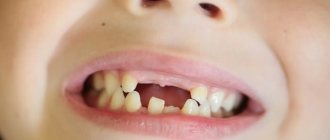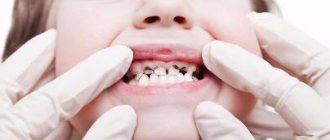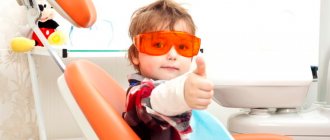From this article you will learn:
- how many baby teeth does a person have,
- How are temporary teeth different from permanent teeth?
- Scheme of loss of baby teeth in children.
Milk teeth are a set of twenty temporary teeth that begin to erupt in a child, usually at the age of 5-6 months (the central incisors of the lower jaw erupt first). The need for temporary teeth is evolutionarily determined by the small size of the jaws of newborns. Permanent teeth are much larger than milk teeth, and their number is 1.5 times greater, and therefore, if children immediately had permanent teeth, they simply would not be able to fit into small jaws.
Because of this, in small jaws, smaller temporary teeth (in a reduced number) erupt first, and only when the jaws reach the desired size does the child replace milk teeth with permanent ones. Therefore, the time when baby teeth fall out in children is integrally connected with the growth of the jaw bones and the development of the rudiments of permanent teeth. Typically, the loss of primary teeth begins in children at the age of 6 years, and in girls this process begins earlier and proceeds faster.
In Fig. 2 you can see how the change of baby teeth to permanent ones in children looks like on an x-ray. In this case, we see that the child has already erupted permanent central and lateral incisors, as well as the first permanent molars. But in the lateral sections of the jaws we also see still preserved milk teeth, between the roots of which the rudiments of permanent teeth are located.
Temporary teeth
Timing of teething
Dental buds are formed during the period of intrauterine development. The eruption of the first teeth begins at the twenty-fifth week of the baby’s life. The lower incisors appear first, followed by the upper ones by eight months. The age at which baby teeth, called premolars, erupt varies from one to two years. The last to appear are the canines and second premolars, which occurs from sixteen to thirty months.
This teething schedule is optimal, but it is impossible to determine the exact timing. The process depends on the characteristics of the child’s body, the health of the mother during pregnancy and genetic factors.
Timing of teething in children in the table
| Type of tooth | Lower jaw | Upper jaw |
| Medial incisor | 6 – 10 months | 7 – 12 months |
| Lateral incisor | 7 – 16 months | 9 – 13 months |
| Fang | 16 – 23 months | 16 – 22 months |
| First premolar (baby molar) | 12 – 18 months | 13 – 19 months |
| Second premolar (baby molar) | 20 – 31 months | 25 – 33 months |
The order of teething in children
The teeth follow the principle of pairing, for example, if one fang appears, a second one should be expected soon. The sequence of teething is determined by nature based on the practical significance of dental units for survival.
The front teeth of the lower row grow first, then the upper ones come. The lateral incisors disrupt the order of teeth eruption; their appearance begins with the upper jaw. Then comes the eruption of chewing teeth - the first premolars. The last to emerge are the canines and molars. The process of teething in children is completed by the age of 2-3 years.
Diagram of baby teeth eruption in children
Is it possible to pull out a baby tooth yourself?
At home, you can remove a baby tooth only if it is well loosened and you can walk freely in the socket.
It is important that the child does not have a cold: coughing, sneezing, runny nose - these are stop signals for home removal of a baby tooth. Examine the child’s mouth - if there is swelling or bleeding of the gums, your manipulations may lead to infection in the socket. It's better to see a dentist.
If you still decide to pull out a baby tooth, it is better not to experiment with tying the object to be removed to the door handle.
The best way is this: wrap the tooth with gauze soaked in alcohol and pull it out of the hole until it comes out. The tooth can also be wrapped with sterile thread and pulled strictly perpendicular to the jaw.
After the manipulations are successful, the child needs to rinse his mouth, the parent needs to see if there are any parts of the tooth left in the socket (if the tooth is broken and something remains, you need to go to the doctor). Sterile cotton wool is placed in the hole for 20 minutes: the child must press it with his teeth to stop the bleeding. Make sure your child does not drink or eat for a couple of hours after tooth extraction.
If the tooth falls out on its own, also put cotton wool in the hole and do not let the baby drink or eat for a while.
Permanent teeth
Timing of teething in children
The first permanent teeth appear several months before the baby teeth fall out—the molars, or “sixes,” erupt. This occurs at the age of six. By the age of eight or nine years, it is the turn of the incisors. When a child is ten to twelve years old, premolars and canines erupt. Next come the second molars, the eruption of molars is completed by adulthood.
Important!
Wisdom teeth appear much later, after twenty years. However, their complete absence is also the norm.
Timing of teething in the table
| Name | Lower jaw - time of eruption | Upper jaw - eruption time |
| Medial incisor | 6 - 7 years | 7 - 8 years |
| Lateral incisor | 7 - 8 years | 8 - 9 years |
| Fang | 9 - 10 years | 11 - 12 years |
| First premolar | 10 - 12 years | 10 - 11 years |
| Second premolar | 11 - 12 years | 11 - 12 years |
| First molar | 6 - 7 years | 6 - 7 years |
| Second molar | 11 – 13 years | 12 - 13 years old |
| Third molar | 17 – 21 years old | 17 – 21 years old |
Teething order
The pairing principle also applies to permanent dental units. The correct sequence of teething is important for the formation of the bite; it is necessary to carefully monitor the time of loss of baby teeth and the order of growth of molars.
The lower molars appear first, then the upper ones. Next, the temporary teeth of the lower jaw fall out, the permanent teeth erupt, and only then the upper dental units are replaced.
This schedule for teething in children is not universal, but if there are significant deviations, you should consult a specialist.
What are baby teeth?
A child may believe that baby teeth are needed only so that the Tooth Fairy has something to build her snow-white castle from. But adults should know the truth. When a child is still very small, his head, and therefore his jaw, are small. If the baby, instead of milk teeth, began to cut molars immediately, they would not fit into the mouth either in size or in number. Therefore, nature gave us a temporary solution for the first ten years.
There are 20 primary teeth in total (10 each on the upper and lower jaws). These are incisors - central and lateral, canines, and molars. Usually, a child already has all of them at the age of 3-3.5 years.
Milk teeth differ from primary teeth not only in size, but also in structure. The enamel of primary teeth is approximately 2 times thinner and not as rich in minerals. Therefore, the child needs to carefully monitor oral hygiene - caries on baby teeth develops very quickly. Milk teeth have thin not only enamel, but also the layer underneath it - dentin - so caries quickly develops into pulpitis. Baby teeth have both nerves and roots, but they are shorter than molars. The latter gradually “dissolve” during the period of change of bite. This is why the teeth begin to loosen.
If baby teeth are not taken care of and treated, the child’s gums may become inflamed, and the embryos of the molars may suffer or die. Don't leave caries unattended!
Signs of teething
Symptoms of teething in infants
The appearance of baby teeth is a little more difficult than that of permanent teeth, since the baby has not yet encountered pain and cannot understand what is happening to him. Teething in children under one year of age is accompanied by the following signs.
- The most common symptom of teething is fever. An increase to 38 degrees within three days is normal.
- Swelling of the gums. Often, when children are teething, their gums swell, their sockets itch, and they have a desire to chew hard objects. It is important to prevent the child from damaging the mucous membrane; it is better to buy a special teether to relieve discomfort.
- Decreased appetite. Children refuse to eat due to stress or itchy gums.
- Teething syndrome. Neurosis, tearfulness, anxiety, poor sleep and whims may indicate the imminent appearance of the first tooth, even if the child does not experience pain, fever or swelling of the gums.
Important!
An increase in white blood cell levels during teething should not be a cause for alarm. This is a common occurrence associated with a weakened immune system.
Symptoms of eruption of permanent teeth
A change in temporary bite is accompanied by other unpleasant sensations. The process has the following characteristics.
- Root resorption and loss of baby teeth. A sure signal of the appearance of a new tooth in the coming months.
- Increase in jaw bone size. Permanent teeth are larger than baby teeth, the jaw grows, creating conditions for a change in bite.
- Pain in the gums. Redness and swelling of the mucous membrane are a reaction to teething.
Important!
Body temperature above 38 degrees, cramps, refusal to eat and difficulty breathing are not symptoms of the appearance of milk and permanent teeth. These are signs of an infectious disease. It is necessary to urgently consult a doctor.
After a year, teeth appear with the following frequency:
- by 12-15 months – two pairs of first molars erupt;
- by 18-20 months – a pair of upper and a pair of lower canines are already clearly visible;
- 20-30 months is the period of appearance of two pairs of second molars.
How many teeth should a child have at 1 year 3 months? Ideally 12, but the number can change in one direction or the other, and this is not considered a deviation. The frequency of teething is influenced by many factors, including previous infections, heredity, climate, and health status.
The question of how many teeth a child should have at 1 year 8 months, or 20 months, also cannot be answered unambiguously. The answer will be approximate - about 16. Up to a year, parents should focus on the approximate formula: the number of months minus 4, with a reservation for the baby’s characteristics.
Painful teething: advice for parents
When faced with teething in children, many parents are at a loss. First of all, you need to call an ambulance and determine the reason for the baby’s poor health. If symptoms are confirmed, the specialist will prescribe medications for teething - antipyretics and painkillers.
You can treat your gums yourself with an anesthetic gel with a cooling effect to reduce itching and swelling of the mucous membrane. Ice will also help. To reduce gum irritation, there are special silicone fingertips made of hypoallergenic material.
Folk remedies for teething will effectively relieve painful sensations - a decoction of chamomile, sage, tincture of valerian and honey will soothe inflamed tissues.
Painkillers for teething are contraindicated in children; this can worsen their health.
Important!
Without a doctor's recommendation, antibiotics and other strong teething medications can cause an allergic reaction.
Maxillary premolars
The crown of the premolars on the upper dentition has a prismatic shape. The buccal and palatal bones often have a convex surface. The first and second premolars in the row also have their differences.
First premolar
The difference between the first premolar of the upper jaw is the predominance of the vestibular surface over the palatal surface. Its contact surfaces are rectangular in shape. The buccal tubercle has two distinct slopes. The root of such a tooth often has a bifurcation.
Second premolar
In such a tooth, the buccal surface usually predominates over the palatal surface, which is more rounded. In most cases, this premolar tooth has a single cone-shaped root. However, there are also cases when it has a split.
Deviations in teething
Minor changes in the timing and sequence of dental growth should not cause alarm. However, significant deviations from the norm in teething are a cause for concern.
- The tooth does not appear for a long time. Reason: genetic predisposition to long eruption or lack of rudiments.
- Too early appearance of teeth. Caused by disruption of the endocrine system.
- Black or brown enamel surface color. Indicates high iron levels, poor salivation, or chronic inflammatory processes in the child’s body.
- Incorrect row position. Bite pathologies indicate a hereditary factor or deformation of the maxillofacial bone.
Features of the structure of molars
Molars have a characteristic structure. On the upper jaw they have three roots and four canals. The lower jaw has two roots and three canals. Moreover, the number of canals also differs depending on the location of the individual tooth. Thus, the first of them often have one more channel than the next two.
The main characteristic feature of this type of teeth is the area of their chewing surface. They bear the heaviest load when chewing food particles. The molars themselves also have differences among themselves, which are associated with the structure of the jaw.
Causes for concern
When a child remains without teeth after turning one year old, parents should take him to the doctor. Of course, the time at which chewing organs appear may vary. For example, in boys this process occurs more slowly than in girls. But, there are situations when medical consultation is absolutely necessary.
- An urgent visit to a pediatrician is necessary at a high temperature of more than 39 degrees.
- The baby should be shown to a doctor if symptoms such as frequent diarrhea and vomiting develop.
- An orthodontist is consulted if a malocclusion is suspected. Perhaps, after the eruption of incisors, canines, and molars, he needs therapy. In such situations, braces are used for children while the jaw apparatus is pliable.
- A specialist should examine a newborn whose units appeared in the prenatal period.
- A dentist is consulted if the organs are not formed in the dentition.
Therapy may consist of strengthening the health of the toddler, performing special exercises, and massaging the gums.
What microelements are needed for teeth growth?
Vitamins and microelements are a necessary component for the development and normal functioning of the child and adult body. The formation of dental tissue cannot do without:
Fluorine
Strengthens enamel, makes incisors resistant to bacteria, the destructive effects of acids, and prevents caries. Fluoride is taken in tablets or drops when a deficiency is diagnosed. Enters the body with sea fish, nuts, grape juice, spinach, and most vegetables.
Toothpastes with fluoride are not approved for use by children under 4–5 years of age. Children aged 1.5–3 years swallow the tasty mass when cleaning their mouths, and an excess of the element is formed in the blood. For foolish children, choose toothpastes without fluoride to protect them from the negative consequences of hygiene procedures.
Calcium
It is the building material of infants' teeth. Without calcium, mineralization in tissues is impossible. After finishing breastfeeding, a one-year-old child should receive dairy products daily, greens and fish at least three times a week.
Vitamin K
Necessary for complete absorption of calcium and protein synthesis. Found only in natural dairy products (cottage cheese, sour cream and others).
Teething for young parents seems like an extremely difficult and nervous process. They prepare for it mentally, they are afraid of hysterics and hyperthermia.
Young and inexperienced parents do not need to worry or be negative. It is better to study the issue of dentition in infancy in order to arm yourself with knowledge and understand why the baby cries and is nervous. In this case, jaw development will be perceived as a normal physiological stage of growth, which will be experienced easily and quickly.
Milk and molar teeth: what are their differences?
Externally, baby teeth and molars are very similar, but if you look closely, you will notice some visual differences: baby teeth are smaller in size, and the incisors and canines have a more rounded shape. The main differences are related to anatomy and structure.
- Primary teeth have thinner enamel with less mineralization.
- The root canals of baby teeth are much wider and, accordingly, more susceptible to the entry of pathogenic bacteria.
- The dentin layer of baby teeth is thinner, and the pulp is thicker.
- Milk teeth have roots, but they are less pronounced and dissolve during the process of changing the dentition.
What should mom do?
When teeth erupt out of order, every parent should take this fact seriously. Pediatricians advise feeding your baby in a balanced manner. For six-month-old children, mother's milk is not enough. Complementary foods should be introduced gradually. Mothers should properly allocate time for wakefulness and sleep, and visit the doctor according to the schedule. A vitamin complex may be prescribed. It is prohibited to select medications on your own, since only a doctor can give an objective assessment of the baby’s condition.
If the chewing organs do not appear according to the calendar, specialists prescribe certain tests to determine the cause of the failure. Mom should not neglect the doctor's recommendations. Its instructions should be followed exactly to stimulate the appearance of units. To do this you need:
- Include foods rich in vitamins in your diet;
- Correctly create a daily routine and monitor its implementation;
- Conduct comprehensive physical exercises with children;
- Regularly visit a doctor for preventive purposes;
- Treat illnesses in a timely manner;
Taking medications without a doctor's recommendation is dangerous and detrimental to a child's health. Only care and affection, proper care and feeding will allow you to raise a healthy child.











